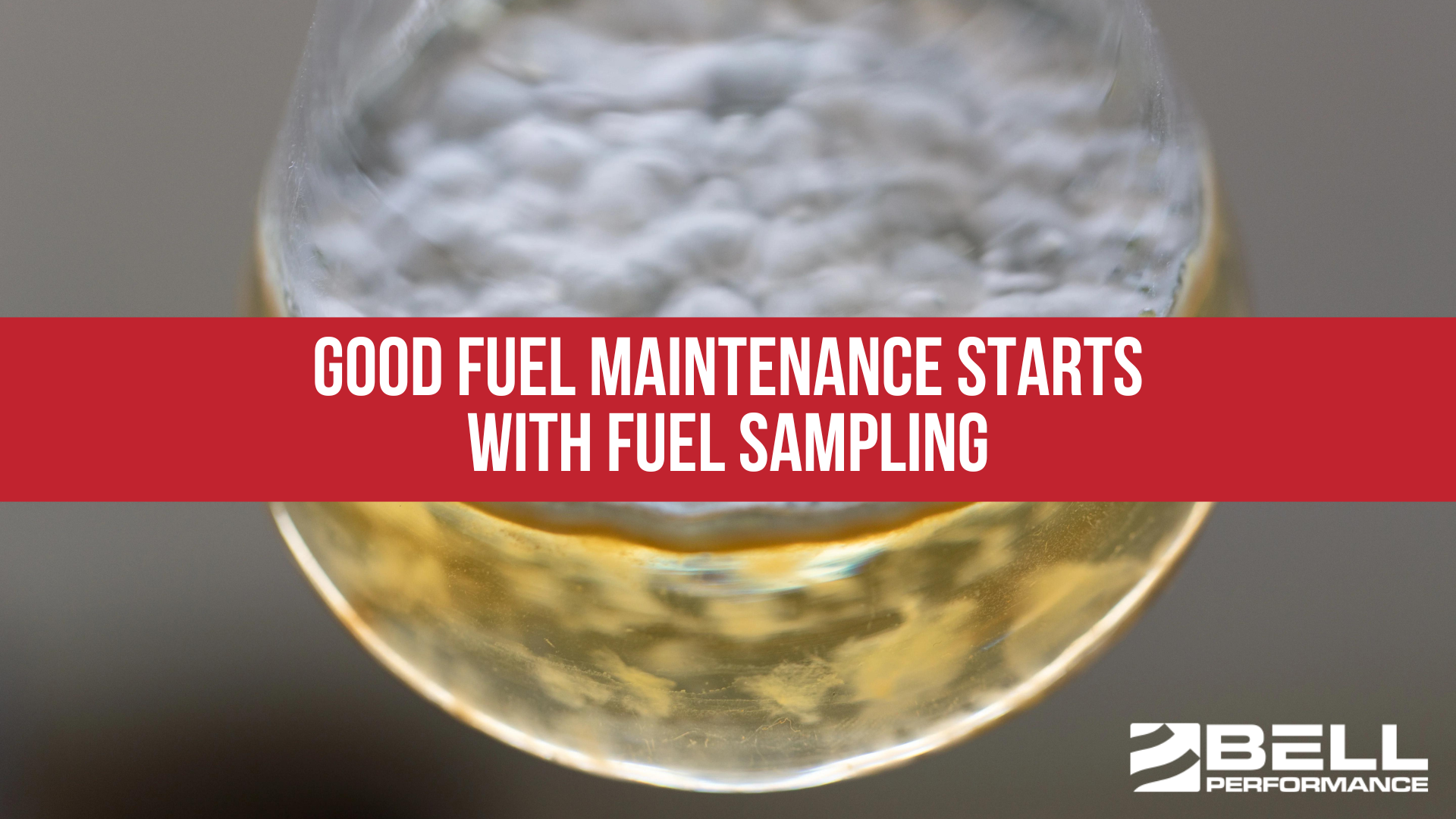Fuel Testing & Understanding Your Fuel's Properties
Taking care of today's problematic stored fuels is best done with the three-pronged Hybrid Approach - the right chemicals, the right mechanical...
5 min read
Erik Bjornstad : Apr 4 2019


Often, what gets blamed for fuel degradation and/or changes to the fuel’s condition for the worse is microbial contamination. This is for good reason. Microbial contamination is the number one cause of fuel condition problems in today’s marketplace, for a variety of reasons – today’s fuels don’t resist microbial growth like they used to, and it’s simply too easy for microbes to get into fuel storage tanks by any number of means (you just can’t keep them out).
Up until now, there weren't many good options for fuel professionals to assess fuel microbial content where they were at. For a long time, there really wasn’t any feasible way for fuel managers or anyone in charge of fuels to do this; it was all guess work. If you were really progressive at the time, you’d think to pull a fuel samples and package them to send to a testing lab. They’d charge you $500 or so, do a culture test on your sample, and you’d get results back in 3-4 weeks – too long to be of any practical use. What was needed in the marketplace was a good way for those charged with monitoring the fuels’ condition to actually measure what was going on.
Fortunately, times have changed. Now there are many more options for the fuel manager to do their own monitoring of their fuel’s microbial condition. Yet, not all of these options are created equal, so to speak. They’re not all equally good. The whole thing can be confusing if you don't know what you should be looking for.
Following is a quick guide to the pros and cons of what’s available to the fuel professional. It really falls in the middle of best practices to start doing this if your job entails looking after fuel of any sizable volume. Hopefully this will help you make the right decision on how to best do that.
Pros: Easy to run
Cons: Too general in their results; takes a long time to get results
Examples: “LiquiCult”, “dip slides”, MicrobMonitor2
These are small-scale versions of the type of test a lab would do (though the lab would use different equipment to do so). These in-field tests rely on re-growing the microbes in whatever sample you’ve pulled, and then giving you some kind of indication of their presence. Some tests use slides that are impregnated with growth medium for the microbes, others use liquid or gel that you inject a sample into and then leave to grow. On the plus side, they’re pretty easy to run. But that’s about the extent of the positives. Their down sides are that they’re not very exact in their results and they take a long time to get results (3-5 days). When you need to know the condition of your fuel, there are better options all-around than these old-school options.
Pros: Faster and (somewhat) more specific results than with culture tests
Cons: You get to say ‘lateral flow device’ (kidding); individual tests can’t be calibrated; expensive
Examples: H. Resinae tests
These “LFD” tests are a step forward from the culture tests because a) you get results in a shorter period of time, b) they give you separate results for bacteria (including a separate result for the specific H resinae bacteria that is thought to be commonly found in fuel storage situations) and molds/yeasts (which some might find useful), and c) they give you a specific high/low reading.
The downsides are that the high/low readings may not be as useful as they should be (what does low mean? How much is high?). The results are what would be termed "semi-quantitative"; the results (negligible, moderate, heavy) correspond to ranges instead of specific numbers. A negligible result, according to the scale provided by the manufacturer, means your microbial content would be below a certain amount (the manufacturer scale talks about micrograms of 'substance' associated with microbes) i.e. less than 33 micrograms. A moderate reading corresponds to a value between 33 and 166 micrograms per mL. A heavy reading is over 166 micrograms per mL.
This is certainly better than not having any kind of scale to relate these "low-medium-high" results back to. But semi-quantitative has distinct limitations for what it's telling you. How many microbes (or what they would call Colony Forming Units or Microbial Equivalents) do these microgram figures correspond to? A microbiologist would say it depends, because different kinds of microbes contain differing amounts of measureable substances like this kind of test would detect. But if you want to compare results from an LFD with results (whether past or present) done by another method like a culture test), you're going to find it difficult to do that. Simply put, this kind of semi-quantitative result is better than a more primitive yes/no reading, but is significantly less useful than a more specific estimate of a microbial count that you would get from a different kind of test.
And the other big problem is that they can’t be calibrated. Actually, let's explain further on that. Each LFD test has a control line that functions as a positive control - it shows whether the test is working correctly. But this only functions after the fact. If you run a test and the control line doesn't show the test is still good, that test is invalid and you've wasted the money, which is not an insubstantial amount.
Now, there is a special calibration test available from the manufacturer, but it can only be done on a single test in a package - which means that if you have a box of ten tests and you calibrate one of them, you still don't know if the others are still "good" or not. All of this may not seem like a big deal, but these lateral flow devices use specific indicator substances that are temperature sensitive, so it’s possible to deactivate the test if you mishandle it (like leave it in a hot truck). Yet, without calibration, you wouldn’t know the test wasn’t working; all you’d get is a false negative. And that’s potentially a big problem, especially when an LFD test slate can cost $50-90 (or more) to run.
Pros: More specific results than culture tests or LFDs; quick results (<5 minutes)
Cons: Questionable accuracy (because of really small sample size)
Examples: ATP “pen” tests
The next step up after culture and LFD tests are the ATP pen tests that have been around for maybe ten years. The principle behind them is state-of-the art and definitely worth paying attention to. They calculate the actual number of microbes in a sample by measuring the amount of ATP (a molecule that every living cell has) contained in the sample. So you get more specific (and useable) results in a much shorter time. But it’s worth remembering that the “pens” are really just the first-generation version of a really useful testing technology for stored fuel and other application. As such, they can have problems with accuracy due to the really, really tiny sample size they use to run the test. We’d still put them ahead of the culture and LFD test options, though.
Pros: The most specific results available; quick results (<5 minutes); higher degree of accuracy and sensitivity than previous tests
Cons: Takes practice to run
Examples: Fuel-Pulse ATP-L testing
These next-generation tests weren’t really available 5 years ago, and use the same principles as the first-generation pen tests, but with much better accuracy. You use a filter to isolate the microbes from your sample and add a couple of liquids to separate out the ATP so it can be measured with a very high degree of accuracy.
Ultimately, these next-generation ATP tests give you everything you need in this kind of fuel management test. They enable you to calculate how many microbes are actually in your sample, so you don’t have to guess. They give you results in about 5-7 minutes. Plus, you don’t have the calibration problems that you do with LFD tests, so you know your results are accurate.
Best of all, these next-generation ATP tests don't cost an arm-and-a-leg to run, or to have run - some companies offer testing kits with everything you need to package up a fuel sample and ship it to a lab where they will do the fuel testing for you.
All things considered, the recent availability of ATP-by-filtration testing is a quantum leap forward for fuel managers, giving them the kind of information they need but never had before. This helps them to make the best decisions on maintaining their fuel’s condition while avoiding microbial contamination problems. Not to mention being able to fix them when they do arise.
If you’re doing the kind of condition monitoring you should be doing on your stored fuel, the next-generation ATP tests would be the way to go.
Taking care of today's problematic stored fuels is best done with the three-pronged Hybrid Approach - the right chemicals, the right mechanical...
We’ve Never Had To Do Fuel Testing Before, So Why Now? Because fuels have changed and are not what they used to be. That's the simple answer. You...

Imagine a scenario where a hospital faces a power outage but finds its backup generators faltering due to poor fuel quality. Such a situation...